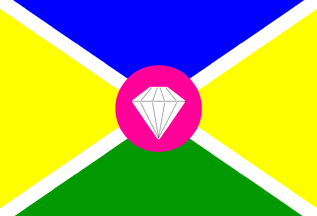 image by António Martins-Tuválkin,
22
September 2025
image by António Martins-Tuválkin,
22
September 2025
Last modified: 2025-10-18 by ian macdonald
Keywords: bahia | boninal |
Links: FOTW homepage |
search |
disclaimer and copyright |
write us |
mirrors
 image by António Martins-Tuválkin,
22
September 2025
image by António Martins-Tuválkin,
22
September 2025
Quatered diagonally by a white saltire, blue and green in top and bottom, yellow in hoist and fly, with a logo of a white diamond gem on a centered pink disk.
Links:
https://pt.wikipedia.org/wiki/Boninal
https://www.instagram.com/p/DHwLnVsxryS/?img_index=1
https://www.mbi.com.br/mbi/loja/brasil-regiao-nordeste/bandeira
Valentin Poposki, 20 September 2025
On this photo we can
see the flag hoisted indoors along the national and state
flags; it was attached upside-down to the pole and the disk is
pink/magenta. While the former is a mishap, the pink disk (as opposed to a red
disk)
suggests that the images in Commons were mistakenly copied from the
undisclosed official source given as Site da Prefeitura de Boninal, but
no link. With that in mind, the image above uses RGB:FF0099 for the central disk.
This flag shows a white gem (rosecut diamond seen in profile) with black
hairlines, set on a pink/magenta/purple central disk, superimposed on a
thin white saltire, itself set on a background divided saltirewise with
yellow at the fly and hoist plus blue at the top and green at the bottom. The
diamond seems to refer to local history, guessing from what is mentioned in
the Portuguese Wikipedia article, linked by Vanja. Still according to the
Portuguese Wikipedia article, the current town name was chosen in 1943-1944,
more than ten years after the end of the diamond mining cycle, in 1931.
The word "boninal" means "daisy field" and therefore the flag is not
canting, regardless of whether one assumes the bonina in question to be
Bellis perennis (the daisy, European style), or Mirabilis jalapa
(the
four o clock flower), as is more likely in Brazil. Indeed, eight of the
latter species are featured on a current official municipal logo:
https://www.boninal.ba.gov.br
António Martins-Tuválkin, 22 September 2025